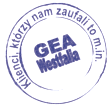Operation of cranes
Safe use of the crane
Persons who are qualified by the Office of Technical Inspection (UDT) are allowed to work with cranes. Such qualifications are obtained by attending an UDT training course and passing an examination. In order to avoid accidents, it is necessary to comply with health and safety regulations when working on the equipment.
Device control
Before starting work, the person authorised to drive the machine should carry out a number of checks. This will ensure safety at the work site.
The tasks of the crane operator before starting work include:
- visually check the efficiency of the equipment,
- checking that the security mechanisms are working properly.
Visual inspection of the crane:
- making sure that the crane is not undergoing technical supervision or maintenance work,
- making sure the gripping device is in perfect condition,
- checking that the warning signs are in place,
- checking the condition of the running wheels of the winch or hoist and the bridge,
- ensuring that the safety guards are correctly fixed,
- making sure that the load chain or rope is well seated and in good working order,
- checking the running track for play and deformation and that all track components are securely fastened,
- checking for leakage of various types of fluids and lubricants,
- making sure that the control cassette is working properly,
- ensuring that there are no other hazards preventing the equipment from operating.
Checking safety mechanisms:
- checking that the main power switch is working properly,
- control of the operation of control instruments,
- making sure that the loaded brake is working correctly,
- making sure that all movements of the crane are visible on the control panel,
- checking the operation of the load limiter,
- monitoring the operation of the slipping clutch,
- open the movement-locking devices, if the crane has them,
- making sure that the limit switches on the travel and lifting mechanism are working correctly,
- making sure that warning lights, lamps and audible signals are in good working order,
- monitoring the operation of a button that can be used as an emergency stop,
- checking the operation of the drive mechanisms.
Overhead cranes that have certain deficiencies or are damaged must not be operated. They should be immediately taken out of service at the workplace. Only cranes that are approved by the UDT may be used.
The main activities that the crane operator performs during operation:
- works in a safety helmet if such a rule is in force at the workplace,
- checks that the crane assemblies and mechanisms are operating correctly,
- when he hears a STOP message, he always complies with it, no matter who issued it,
- always comply with the whistleblower's messages,
- when working, he has a good view of the route on which the goods are being moved and is assisted by another person when the load obstructs his route,
- controls that there are no people under the load that is up,
- places the load correctly using the gripping device,
- remembers to take loads up vertically,
- ensures that the sharp edges of the load are secured,
- ensures that the goods are compatible with the permitted capacity of the crane.
Questions and answers
Can anyone operate cranes?
A person holding a licence issued by the Office of Technical Inspection is permitted to work on a crane.
What must an operator do before working on a crane?
The person operating the crane should first visually ensure that the equipment is in working order. Then check that its control mechanisms are working perfectly.
What are the tasks of an overhead crane operator during their work?
The crane operator directs the machine, which moves loads to the desired location. While working, he or she observes safety rules to ensure that no one gets hurt and that the load reaches its destination intact.

































